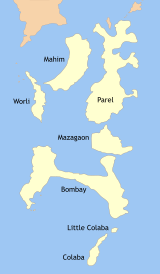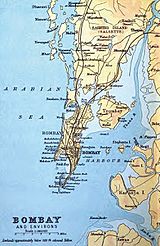Seven Islands of Bombay facts for kids
The Seven Islands of Bombay were a group of islands in India. They were owned by the Portuguese in the 1500s. These islands were located off the Konkan coast, which is on the mid-west side of India.
Contents
A Look Back at the Seven Islands
The Seven Islands of Bombay have a long and interesting past. Before the Portuguese, local kingdoms like the Silhara dynasty and the Gujarat Sultanate ruled them. In 1534, the Portuguese Armadas captured the islands.
From Portugal to England
In 1661, something big happened. The islands were given to England as part of a dowry. A dowry is a gift of money or property given by the bride's family when she gets married. In this case, Catherine Braganza, a Portuguese princess, married King Charles II of England. The islands were part of her wedding gift.
A few years later, in 1668, King Charles II leased Bombay and its nearby small islands. He rented them to the East India Company for a very low price: £10 per year. The East India Company was a powerful British trading company.
How the Islands Became One Big Land
Over time, people started to connect the islands. By 1845, many land reclamation projects had taken place. This means that land was created in the sea to join the islands together. This turned the seven separate islands into one large landmass.
This new, bigger island of Bombay later joined with other nearby islands. These were Trombay and Salsette, which were to its north-east and north. Together, they formed what is now known as Greater Bombay. Today, these islands make up the southern part of the big city of Bombay (Mumbai).
The Original Seven Islands
The original seven islands that were given to England were:
- Colaba
- Isle of Bombay
- Mahim
- Mazagaon
- Old Woman's Island (also called Little Colaba)
- Parel
- Worli
Other Nearby Islands
There were also several smaller islands located to the east of the main seven islands:
- Butcher Island
- Cross Island
- East Ground
- Elephanta Island, also known as Gharapuri
- Middle Ground
- Oyster Rock
See also
 In Spanish: Siete islas de Bombay para niños
In Spanish: Siete islas de Bombay para niños



